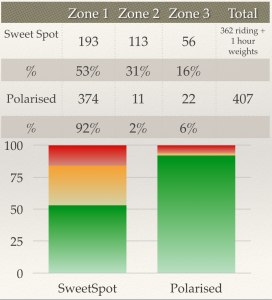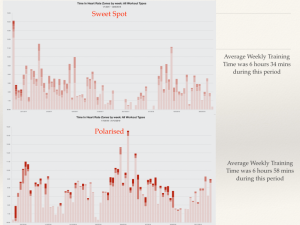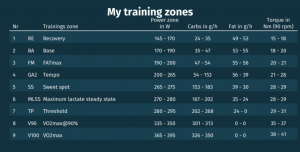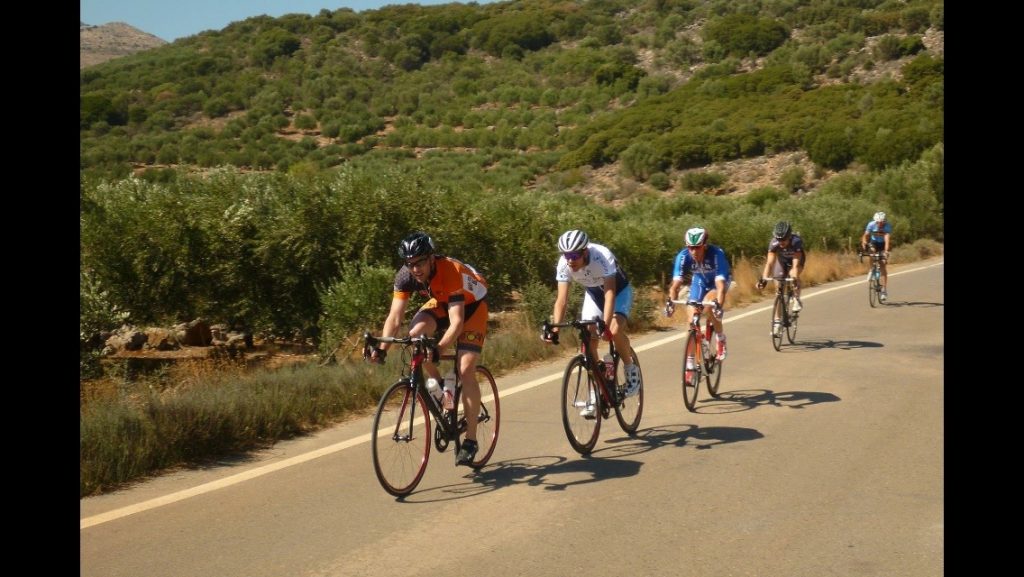
What is Intensity Distribution?
I spent years training and racing without really understanding what it was. I had an understanding that some rides should be easier/harder…but actually, looking back at my old training diaries, there was relatively little variation.
The topic has become more popular with the rise in popularity of polarised training. This primarily comes from Stephen Seiler and other researchers in Norway. They broke down the training of many high-level endurance athletes and found a very specific commonality. The best endurance athletes in the world train EASY most of the time. Their original finding was that 80% of sessions were easy Z1 (in a 3 zone model), with the remaining 20% OF SESSIONS being high intensity (Zone 3).
When you look at time in zone, their numbers are closer to 90% in Z1 and 10% in Z3. The top endurance athletes seem to spend very little time in Z2, which in the 3 zone model will be around sweet spot/threshold.
Once I started paying attention to this there was a marked improvement in performance, no burnout, less illness and I started PB’ing at all distances I time trialed in!!
Sweetspot/threshold training is a distribution where there is much more focus in training around threshold. I did this for years, but found myself getting ill fairly regularly and burning out a lot…so the long term gains just weren’t there.
Pyramidal training is more balanced, still a large amount of Z1, but with more Z2 than Z3.
Polarised, Pyramidal, Threshold or Something Else?
There are many training models out there. To some degree, they will all help in some way or other. I have a bias towards a more polarised/pyramidal model as that’s what has worked for me. I’ve also had bad experiences of burnout and overtraining when following sweet spot and threshold plans.
Here are my distributions for 18 months prior to changing to polarised and the 18 months training polarised.

Though you could argue the left bar chart suggests it is a pyramidal distribution, I’d say there isn’t enough base (Zone 1) for that.
Do you Have to Choose One?
This is the key question for me and is the question in my mind that inspired this post, do you really have to choose one? I’d suggest you don’t.
As always in coaching there are a lot of variables that affect your choices:
- Long Term Training History
- Recent Training History
- Goals
- Time of the Year/Season
- Time relative to Goal
- Age
- Life style outside of cycling
- Life stress
I could go on…that’s a long list already and it’s by no means exhaustive!! There are loads more.
Coaching should always be made as individual as possible, in my context I work one to one with riders, so I can take into account all these factors when programming their training.
So What Should you Do?
Here’s a distribution of my heart rate data for the 18 months before changing and the 18 months after switching to polarised training. The total amount of training was similar, but the amount of Z1 is an obvious change, also clear time in Z3.
Another big deal is the amount of time off for illness in the top graph. Consistency is key to endurance performance and intensity control is key to consistency!!

I think there are layers to programming…to start it’s good to choose what you think will work best for you and your situation. If you have a global idea of what you want to do, you can start breaking things down into smaller chunks (month plans, week plans) and finally you know what each session goal should be.
At the very start, I’d just keep it simple and choose one…and for me, it’s between polarised and pyramidal.
I would recommend polarised training if you are:
- New to structured training
- Coming back after a break from training
- Coming from a very high intensity or threshold focussed training
I say this because getting your intensity distribution under control is the best thing you can do in all of these situations.
In these situations, I would recommend Pyramidal training:
- Already do large amounts of base (Zone 1) training
- Concerned about the high intensity (Z3) training
How to Progress
Once you’ve got your intensity distribution under control and built a good base you’ll want to progress to help maintain adaptation and progression.
I’d say I had two step changes in ‘feeling of fitness’, one after about 3 months of polarised training and another after about 5 months. At that point, I was flying and really hadn’t done a lot of ‘hard work’!!
At this point, if you are using a polarised approach; starting to mix in a little more threshold may be appropriate. I’d still say you are looking at around 70-75% Z1, 20-25% Z2 and ~5% Z3. A lot of this may come from starting to race but can also come from your race-specific preparations.

Periodised Training
Everyone knows training should be periodised, but you can be really smart with your intensity distribution; periodising it so your amount of base can be increased at the right time with a touch of intensity to keep you ticking over (polarised approach) to allow for a big block of training or racing where the distribution may be more pyramidal.
Any Questions?
Feel free to get in touch with any questions:
Make a Plan
With a coach, you are part of a team. Together we make a plan tailored to your goals and your lifestyle
The Work
You still need to do the work. But we’ll be with you, keeping you motivated and on track.

